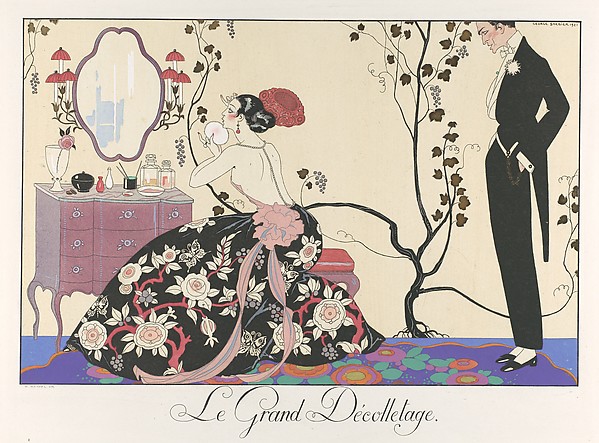The Metropolitan Vanities Hold A Variety of Beautifying Paraphernalia

Le bonheur du jour; ou, Les graces a la mode; George Barbier (French, Nantes 1882–1932 Paris). 1924, French, Paper. Purchase, The Paul D. Schurgot Foundation Inc. Gift, 2002. Metropolitan Museum of Art, Lila Acheson Wallace Wing, first floor, Gallery 909
Few pieces of furniture have revealed more about leisure pursuits, popular taste, and changing social customs than the dressing table, or vanity. Metropolitan Vanities: The History of the Dressing Table at The Metropolitan Museum of Art explores the evolution of the modern dressing table. The age-old impulse to be attractive or fashionable informs and animates much of the dressing table’s lengthy design history, as it does many of the objects associated with the toilette, the ritual in which the dressing table reached new heights of elegance and sophistication. The exhibition provides an overview of the origins and development of the dressing table from antiquity to the present day with some 50 related objects, paintings, and drawings selected mainly from the Metropolitan’s collection.
Metropolitan Vanities: The History of the Dressing Table will be open until April 13, 2014.
The history of the vanity begins with a box. From ancient times ornate boxes have been crafted to hold a variety of beautifying paraphernalia, including jars for cosmetics, flasks for rare perfumes and exotics oils, implements for applying makeup, and mirrors. It was in the late 17th century in Europe that the form of the vanity as we know it today began to develop.
In the late 17th century, European high society began commissioning luxurious specialized furniture from craftsmen and furniture makers. The poudreuse in France, and the low boy, Beau Brummel, and shaving table in England served as models for the dressing table. Jean-François Oeben and Roger Vandercruse Mechanical Table (1761–63) is one of the finest examples of this period in the exhibition. This table was artfully engineered so that the top slides back as the front moves forward to reveal the vanity mirror and additional compartments. The table was most likely intended for Madame de Pompadour’s château overlooking the Seine. The design telegraphs the marquise’s place in society by way of various symbols, for example the tower — the main emblem of her coat of arms — is depicted at the top of the gilt-bronze mounts at each corner.
Pages: 1 · 2
More Articles
- National Archives Records Lay Foundation for Killers of the Flower Moon: The Osage Murders and the Birth of the FBI
- Nichola D. Gutgold - The Most Private Roosevelt Makes a Significant Public Contribution: Ethel Carow Roosevelt Derby
- Oppenheimer: July 28 UC Berkeley Panel Discussion Focuses On The Man Behind The Movie
- Julia Sneden Redux: Age Rage; Sometimes You Just Have to Strike Back
- Rose Madeline Mula Writes: Van Gogh and Me
- "Henry Ford Innovation Nation", a Favorite Television Show
- Julia Sneden Wrote: Going Forth On the Fourth After Strict Blackout Conditions and Requisitioned Gunpowder Had Been the Law
- Julia Sneden Wrote: If The Shoe Fits ... You Can Bet It's Not Fashionable
- The Stettheimer Doll's House: For 19 Years, Carrie Stettheimer Worked on This Three-dimensional Work of Art
- Joan L.Cannon Wrote: A Family Inheritance: More Than 'Things' ... Emblems of Our Lives






